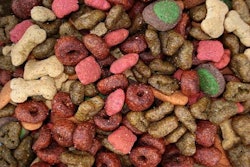At IFT15, this year’s edition of the Institute of Food Technologists’ annual expo and conference held July 11-14 in Chicago, direct pet food information and examples were scarce; yet, as in most years, human food trends and information offered many possible insights for pet food product development.
For several years, the IFT conference included at least one session about pet nutrition and pet food, typically a collection of short presentations, spanning about two hours, at a very high overview level—fitting for an audience comprised mainly of people without an extensive background in the industry or companion animal nutrition. At this year’s conference, such a session was glaringly lacking, which was especially puzzling considering that IFT has published articles about pet food within the past year. I asked an IFT media contact about this, but she was unable to provide any information.
Yet, people within the human food industry still seem to have an interest in pet food. Among the few booths I stopped at on the IFT expo floor the day I attended, several people who noticed my Petfood Industry affiliation asked me questions about the pet food market or commented that they have considered looking into our industry as a potential opportunity for their businesses.
At the Innova Market Insights booth, a large display of innovative food packaging even included one pet food example: a resealable plastic pet food tray from RPC Superfos, which the display said was suitable for autoclave production. A booth nearby was displaying liquid supplements, called Pet Flavors, designed to mask the taste of medication when given to pets. (These are marketed mainly to the pet health and pharmaceutical sectors, the booth rep said.)
Of most interest in the Innova booth was its annual, detailed display and presentation of the top 10 human food consumer trends, with expanded information on some, such as “clean to clear label.” Actually, Innova says that this concept—essentially, transparency in ingredient labeling, with shorter ingredient decks and names easily recognizable to consumers, plus increased information on where the ingredients come from—is so prevalent, it can no longer be considered a trend.
In a June webinar, Lu Ann Williams, director of innovation for Innova, described clear label as the “new rules of the business,” driven by consumers, industry, retailers and regulators. She provided survey data showing that 75% of US consumers say they read nutritional and ingredient labels of food products. Interestingly, Williams said she doesn't believe this statistic, because studies show people spend only seconds deciding on products in store; but she believes consumers think reading food labels is important or that they should be doing it, or they're reading labels at home after purchase.
Regardless, this data point was presented on a large display in Innova’s IFT booth, along with these: 73% of US consumers strongly agree that it’s important for them to recognize most of the ingredients on a food label and use them at home; while 28% claim that “clean label” is a factor that influences their food and beverage purchasing decisions. Another poster showed that 91% of US consumers “agree that food and beverage options having recognizable ingredients can make these products seem healthier.”
Considering the humanization of pets, it’s easy to project that at least some of these consumers apply the same type of thinking to pet food purchases, which helps explain why pet owners often gravitate to marketing terms such as “human grade” and toward ingredients they recognize and would eat themselves. Perhaps as pet food packaging begins to include more information, such as calorie content, our industry should take some cues from voluntary initiatives in the human food sector highlighted by Innova, including Facts Up Front from the Grocery Manufacturers Association in the US and traffic-light-style labeling in the UK, both of which distill basic nutrition information into strong graphics on the front of packages.
Other Innova data in its booth and during presentations at IFT might offer clues for pet food:
- “No additives/preservatives” is still the most prevalent “clean label” claim, showing up on 9% (in Asia) to 37% (in Australia) of new food and beverage product launches in 2014. (In North America, it was 16%, 10% in Latin America and 14% in both Western Europe and Africa.)
- Overall, the “free from” trend is still going strong in human foods, just as it is in pet food. And just as grain-free pet food has become mainstream, so have gluten-free claims in human food (especially in the US, where nearly 20% of new product labels have such claims).
- Organic claims have reached to 10% of new food products launched in the US, just slightly less (9%) in Europe.
- The fastest-growing claim is GMO-free, with more than 40% growth in new product claims globally from 2010 to 2014.
- Protein claims, and alternative proteins, continue to increase in human food, growing more than 400%. Innova gave insect-based foods as one example (more on that below).
- Marketing to Millennials is not just a key trend, but also key to companies’ success, as Millennials now account for 32% of consumers globally. As many other sources have noted, Innova said Millennials are very socially engaged, interested in trying new things and care about the environment, sustainability, social causes and a company’s or brand’s reputation. Even though they don’t tend to be brand loyal, they do like to connect to brands and their stories. “Differentiation for Millennials is about returning to things with meaning, which can relate to origin claims or brands that donate to charity,” Innova said.
The conference portion of IFT15 included a session on insect-based ingredients. In its coverage the next day, IFT referred to the session’s turnout as “standing room only.” Actually, it was beyond that; I arrived a little late and couldn’t even fit into the room, let alone find a place to stand. Which tells me that the interest in insects as a protein alternative is just as strong in human food as it is in pet food, judging by the response to a similar session during Petfood Forum Europe in June.
(I happened upon a booth within the IFT expo that offered samples of “artisan granola bars” using cricket flour. They tasted the same as any other granola bar.)
Finally, two additional observations that may be relevant, or even parallel, to pet food:
- IFT always includes a very large area of posters presenting research from academia and industry on various topics related to food, nutrition and food technology. By a very unofficial count, this year’s show featured about 100 posters, and I estimated that at least 75% focused on nutraceuticals and functional foods. (One such poster explained results of a study involving Beagles, though the learnings were being applied to human nutrition.)
- Besides featuring a large Chinese pavilion this year, there was a significant number of other booths representing Chinese companies at IFT, up markedly from the last show I attended, in 2013. Most of these booths featured ingredients; a pet food professional I know who was also at this year’s show expressed surprise at this, commenting on the mistrust of Chinese ingredients outside of that country. That may be the case, but as China’s economy and industries continue to develop, that seems to lead to exporting and marketing outside of the country. Just witness the ever-increasing number of Chinese pet product companies at pet trade shows.

















